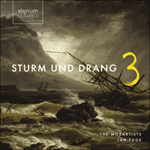
Welcome to Hyperion Records, an independent British classical label devoted to presenting high-quality recordings of music of all styles and from all periods from the twelfth century to the twenty-first.
Hyperion offers both CDs, and downloads in a number of formats. The site is also available in several languages.
Please use the dropdown buttons to set your preferred options, or use the checkbox to accept the defaults.

| The Mozartists, Ian Page (conductor)» More |
The visitor, it was observed, was ‘a young, modishly dressed man of medium height,’ who played ‘beautifully and artfully for a large audience.’ The choir sang Bach’s fine motet, Singet den Herrn, in his honour, and Mozart examined Bach’s autographs: ‘The parts spread all around him, held in both of his hands, on his knees, and on the adjoining chairs.’ Two years later, in The Magic Flute, he would give the Two Armed Men stern, beautiful, hauntingly Bachian music to sing.
The Fugue in C minor dates from six years earlier, when Mozart was first immersed in contrapuntal studies. Originally written for two pianos, it was arranged in 1788 for strings and given the slow, sombre introduction which so strikingly adds to its intensity, yet which Mozart described as no more than ‘a short adagio for two violins, viola, and bass, for a fugue I wrote a long time ago.’ The Adagio is filled with bold, expressive harmonic progressions. The Fugue, once set in motion, rolls on relentlessly to its close. The music, playable by string quartet or string orchestra, has a hard-edged severity quite uncommon in Mozart, but confirming how the Baroque and the Rococo could co-exist in Classical Vienna. A dark, somewhat spooky, conductorless performance of it was given at Herbert von Karajan’s funeral in 1989.
from notes by Conrad Wilson © 2003
 Sturm und Drang, Vol. 3 Sturm und Drang, Vol. 3Three viscerally dramatic orchestral works frame two operatic rarities in The Mozartists’ latest foray into the artistic maelstrom of the 1770s and ’80s.» More |

